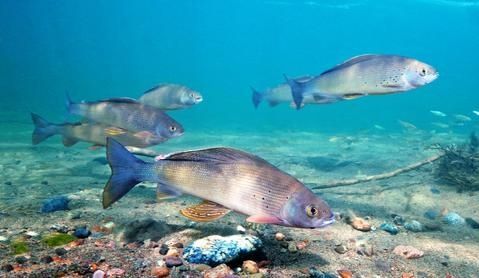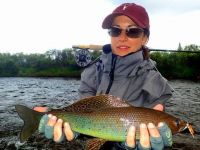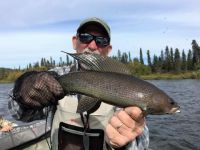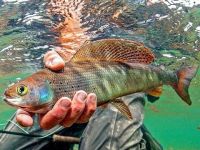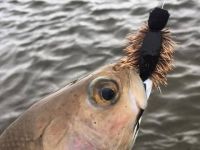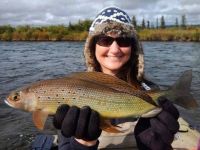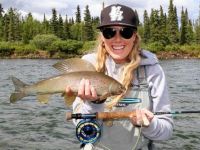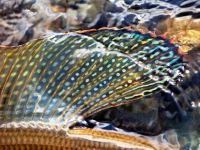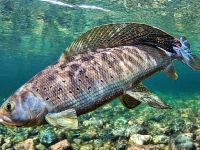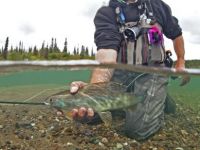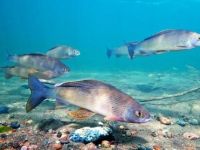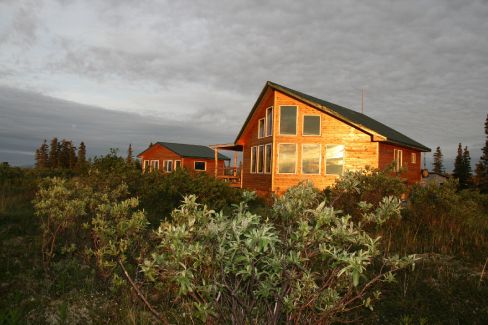With it's sail-like dorsal fin, iridescent markings and dotted with spectacular patterns, the Arctic Grayling is one of the most unusual and beautiful fish of Alaska.
The Arctic grayling comes in a wonderfully wide array of colors, which make it all the more interesting to catch. Once you catch a grayling with a dry fly on light tackle, you’ll be hooked. Grayling fishing can become addictive as they are numerous and where there is one, you will usually catch many more in the same area.
Coloration in Grayling can vary from stream to stream. Their dorsal fins are typically fringed in red and dotted with large iridescent red, aqua, or purple spots and markings. These colorful markings are most dramatic on large Grayling. Arctic Graylings’ backs are usually dark. Their sides can be black, silver, gold, or blue! A band of gold forms a border between their sides and white bellies, which are in sharp contrast to their pelvic fins that have iridescent orange, red, or pink striations. The sides of their body and head can be freckled with black spots. A black slash lies on each side of the lower jaw. The iris of their eyes is often gold in color.
The Alagnak River offers our anglers unlimited access to trophy Grayling fishing all season long.
One of the great things about Grayling is the fact that they always seem to be looking up which makes them prone to taking dry fly patterns even after the salmon start spawning. They will often come clear out of the water on their aggressive takes. It is hard to say when the prime season for this beautiful fish is, as we seem to do well for them regardless of the time of year. A 5/6 wt rod is best for Grayling fishing but you may want to use a 7 wt. in case a big trout comes along.
A female grayling, depending on its size, may have between 1,500 and 30,000 eggs. Because grayling live up to 32 years in Alaska, they may spawn many times during their life time, starting at about 5 to 6 years of age when they attain a size of about 10 to 12 inches. That means, that in well managed rivers, their population can be quite considerable – which means many fish to catch and enjoy! This is one of the reasons many anglers love to target them on our river!
Grayling grow slowly as they dedicate more of their annual energy to spawning efforts (who wouldn’t want to!). Spawning takes place in the spring. Adult fish seek shallow areas of rivers with fine, sand and a moderate current. Males become territorial and court females by flashing their colourful dorsal fins; these large fins are also used to embrace receptive females during the vibratory release of milt and roe. The fish don’t guard their eggs, but leave them to mix with the structure of the bottom of the river. Arctic grayling do not excavate a nest, but their highly energetic courtship hijinks and mating tends to kick up fine material which covers the fertilized eggs, thus protecting them for predation.
The largest Arctic Grayling measured in Alaska was 23 inches long and weighed 5 pounds and 1 ounce.
On the Alagnak we catch many in the 17-20 inch range with the possibility of a true trophy specimen of over 20 inches!
During the brief summer, Arctic grayling are voracious feeders. They will eat almost anything that moves, but drifting aquatic insects, especially black flies, mayflies, stone flies, and caddis flies are their primary food items. Later in the season once the salmon start to spawn, Grayling will gorge upon the eggs of spawning salmon, as well as smaller fish, or terrestrial (land) insects that have fallen into the water. They will even eat an occasional vole or shrew! Research in Alaska has shown that one Grayling had seven shrews in its stomach. Another’s stomach contained 65 chum salmon smolt (small salmon heading to sea).
That means that we primarily fish dry flies, steamers and nymphs to catch our Grayling, but once the egg drop starts, we catch most of our Grayling on bead and egg imitations. One of the most exciting ways of catching them is when one unexpectedly attack a mouse pattern skated upon the surface of the river while we are fishing for big leopard rainbow trout in June!
Arctic Grayling have evolved many strategies to meet the needs of life in Alaska’s often harsh and uncertain environment. Some Grayling migrate, taking advantage of different streams for spawning, growing up, summer feeding, and overwintering. Other Grayling may complete their entire life in only a short section of a single stream or lake.
With the coming of spring, Grayling begin an upstream migration to spawning grounds. Immediately after spawning, adult Grayling begin their migration to summer feeding areas. The travelling distance can be less than 1 mile or as far as 100 miles! Some Grayling faithfully return every year to the very same spawning and feeding areas. So we know where to find them!
You can find Arctic Grayling of different sizes and ages throughout a whole river system. However, there is a discernible pattern of Grayling sizes from a river’s headwaters to its mouth. The older, larger adults tend to lay claim to the cooler upper reaches of river and stream systems. The sub-adults occupy the middle. Juveniles live in the lower reaches of a river; warmer water in the lower river helps speed growth. In the early fall, Grayling begin to slowly migrate back to overwintering areas, which are typically downstream of feeding areas.
Stocks of Arctic Grayling are healthy and not under threat. The Arctic Grayling's insatiable appetite and wide distribution make them a popular sport fish in Bristol Bay and the Alagnak River is a bountiful river when it comes to Grayling!
Because Arctic Grayling have a tendency to eat almost anything, any fishing technique, whether spin fishing with lures, or fly fishing with surface or sub-surface flies, will work.
Grayling are great sport to catch because they are such voracious feeders, but, as with other species, the most skilled anglers with the best knowledge of Grayling feeding patterns and how to fish the water will be most successful.
Fly fishing techniques for Grayling are similar to those used for any trout species. insect imitations such as the dry fly "Adams" and the "hare's ear nymph" are usually effective patterns for Grayling. However, when feeding on a specific insect, Grayling can be very finicky and the angler will be challenged to "match the hatch."
To find out more information about ATA Lodge, visit our website at: www.atalodge.com or call us at +1 877 801 2289.
The source of much of the information in this article is the Alaska Fish and Game website page on Grayling


